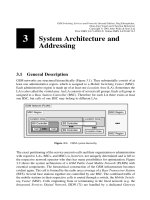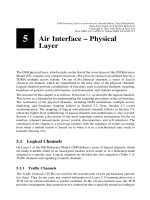OME200301 GSM BTS Trouble Shooting docx
Bạn đang xem bản rút gọn của tài liệu. Xem và tải ngay bản đầy đủ của tài liệu tại đây (491.33 KB, 46 trang )
HUAWEI TECHNOLOGIES CO., LTD. All rights reserved
www.huawei.com
Internal
OME200301 GSM BTS
Trouble Shooting
ISSUE 3.0
HUAWEI TECHNOLOGIES CO., LTD.
Page 2
All rights reserved
References
M900/M1800 Base Station Subsystem
Troubleshooting Manual
M900/M1800 Base Station Controller
Technical Manual
HUAWEI TECHNOLOGIES CO., LTD.
Page 3
All rights reserved
Upon completion of this course, you will be
able to:
Know how to find the fault in BTS
Know the common fault types
Grasp BTS fault disposal method
Know how to prevent the fault
HUAWEI TECHNOLOGIES CO., LTD.
Page 4
All rights reserved
Chapter 1 General Introduction
Chapter 1 General Introduction
Chapter 2 Typical Cases
Chapter 2 Typical Cases
Chapter 3 BTS Fault Prevention
Chapter 3 BTS Fault Prevention
HUAWEI TECHNOLOGIES CO., LTD.
Page 5
All rights reserved
Chapter 1 General Introduction
Chapter 1 General Introduction
Section 1 The Way To Locate Fault
Section 1 The Way To Locate Fault
Section 2 Basic Disposal Method
Section 2 Basic Disposal Method
HUAWEI TECHNOLOGIES CO., LTD.
Page 6
All rights reserved
The ways to locate faults
Alarm
Alarm console
Alarm box
OMC Shell
Traffic statistics
Drive test
Routine inspection
Customer complain
HUAWEI TECHNOLOGIES CO., LTD.
Page 7
All rights reserved
Locating fault equipment
If BSC has fault, usually it will affect some Sites or all of Sites
If BTS has fault, usually it just affect itself and the handover
success rate of adjacent cells
During implementation or expansion, we can “Interchange ”
BTS and judge whether the fault is because of BSC or BTS
During maintenance, BSC faults don’t just affect one BTS
HUAWEI TECHNOLOGIES CO., LTD.
Page 8
All rights reserved
Common fault types
BTS fault
Antenna & Feeder
Transmission
Hardware connection fault
Hardware fault
HUAWEI TECHNOLOGIES CO., LTD.
Page 9
All rights reserved
Chapter 1 General Introduction
Chapter 1 General Introduction
Section 1 The Way To Locate Fault
Section 1 The Way To Locate Fault
Section 2 Basic Disposal Method
Section 2 Basic Disposal Method
HUAWEI TECHNOLOGIES CO., LTD.
Page 10
All rights reserved
Basic disposal method
Analyzing the Alarm Information
Alarm information come from the BSS alarm system, indicated
usually through sound, light, LED, and screen output, etc
It includes the detailed description of the abnormality, possible
causes and restoration suggestions, involves the hardware, link,
trunk and CPU loading ratio, etc It is a gist for the fault analysis and
location
Analyzing the Indicator Status
Indicators can indicate the work status of circuit, link, optical path,
node and active/standby mode besides that of the corresponding
boards, usually used along with the alarm information generally
Analyzing Traffic Statistics Result
It is the most useful method for locating RNO fault.
HUAWEI TECHNOLOGIES CO., LTD.
Page 11
All rights reserved
Basic disposal method
Analyzing Apparatus & Meter Test Result
It reflects the fault nature with the visual and quantified data
Some common Apparatus & Meter
−
Signaling Analyzer, Test phone, Sitemaster, etc.
Tracing the Interface
It is applied in locating the failure causes of subscriber call connection
and inter-office signaling cooperation, etc.
The trace result can help to find the cause of call failure directly and
locate the problem or to get the index for the subsequent analysis
Calling Test
It is a simple and quick method to judge whether the call processing
function and relative modules of the BSS are normal or not
HUAWEI TECHNOLOGIES CO., LTD.
Page 12
All rights reserved
Basic disposal method
Comparison/Interchange
Comparison: compare the faulted components or phenomenon with the
normal ones, and find the differences so as to find the problem
−
It is usually used in the situation with simple fault range
Interchange: if the fault can not be located even after the standby
components are replaced, you can interchange the normal components
(such as board, optical fiber, etc.) with the potential faulted components,
and to compare the work status so as to specify the fault range or part
−
It is usually used in the situation with complicated fault range
Switching/Resetting
It can not locate the fault cause accurately, and due to the randomness
of software running, the fault may be not able to recur, thus it is difficult
to know the real fault and solve the problem
This method is just an emergency method, applicable only in the
emergent situation
HUAWEI TECHNOLOGIES CO., LTD.
Page 13
All rights reserved
Chapter 1 General Introduction
Chapter 1 General Introduction
Chapter 2 Typical Cases
Chapter 2 Typical Cases
Chapter 3 BTS Fault Prevention
Chapter 3 BTS Fault Prevention
HUAWEI TECHNOLOGIES CO., LTD.
Page 14
All rights reserved
Chapter 2 Typical Cases
Chapter 2 Typical Cases
Section 1 Antenna & Feeder Fault
Section 1 Antenna & Feeder Fault
Section 2 Transmission Fault
Section 2 Transmission Fault
Section 3 Hardware connection fault
Section 3 Hardware connection fault
Section 4 Hardware fault
Section 4 Hardware fault
HUAWEI TECHNOLOGIES CO., LTD.
Page 15
All rights reserved
BTS feeder system structure
TX
RX
RXD
T
R
X
CDU
TTA
Feede
r
TTA
Feede
r
arreste
r
optional
Antenn
a
arreste
r
HUAWEI TECHNOLOGIES CO., LTD.
Page 16
All rights reserved
Common faults
Type Fault phenomena
On downlink signal
No downlink signal
MS fails to access the network, calls
cannot be established, call drop, TRX idle
for a long time
Downlink signal
weakened
Poor conversion quality, BTS coverage
shrink
On uplink signal
No uplink signal Calls cannot be established
BTS sensitivity
weakened
Poor conversation quality, BTS coverage
shrink
Feeder system faults
Standing wave alarm Standing wave alarm occurs at CDU
LNA alarm LNA alarm occurs at CDU
TTA alarm TTA alarm occurs at CDU
TTA feeding fails
No DC feeding voltage at CDU antenna
port after TTA configuration
HUAWEI TECHNOLOGIES CO., LTD.
Page 17
All rights reserved
Common faults on downlink
Description
No downlink signal
Downlink signal weakened
Analysis
No downlink signal
−
Step1: View the history alarms and real-time alarm at OMC
or local maintenance console
−
Step2: If there is emergent standing wave alarm at CDU, it is
the most possible cause for which TMU turns off the
transmitter power amplifier resulting in no downlink signal
▪
check the standing wave ratio at jumper side of CDU
antenna port
▪
If the standing wave ratio is beyond limits, locate the
faulty point segment by segment
HUAWEI TECHNOLOGIES CO., LTD.
Page 18
All rights reserved
Common faults on downlink
Analysis
No downlink signal
−
Step3: Since there is no downlink signal, there must be a
broken point in the RF signal path. If this point is located at
the part from CDU antenna port to tower top, then CDU
should be able to detect the emergent standing wave alarm.
Otherwise, it can be concluded that the broken point is
located between TRX output to CDU antenna point
▪
Check whether the cable connection between CDU TX-
COM and TX-DUP is correct
−
Step4: If the operations above fail to locate the failure,
change the CDU
HUAWEI TECHNOLOGIES CO., LTD.
Page 19
All rights reserved
Common faults on downlink
Analysis
Downlink signal weakened: The symptom of this failure is that
the coverage of BTS or carrier shrinks. Follow the steps below to
handle this problem:
−
Step1: Check whether the output power of TRX is normal.
−
Step2: Check whether the standing wave ratio at jumper side
of CDU antenna port is normal.
−
Step3: Check insertion loss of CDU transmitting path.
−
Step4: Check whether the connectors involved in the RF
signal path are tightened
HUAWEI TECHNOLOGIES CO., LTD.
Page 20
All rights reserved
Common faults on uplink
Description
No uplink signal
BTS sensitivity weakened
Analysis
No uplink signal
−
Step1: Try another antenna feeder (CDU excluded) which has proven
to be normal to substitute the one without uplink signal
▪
If the uplink signal at the new feeder recovered while the one at
the original feeder fails, then the original antenna feeder has
problems
▪
If the phenomenon remains, then CDU has problems. Check
whether the cable connection between RXD OUT and HL_IN or
between HL_OUT and HL_IN is correct
HUAWEI TECHNOLOGIES CO., LTD.
Page 21
All rights reserved
Common faults on uplink
Analysis
No uplink signal
−
Step2: If the failure cannot be located yet, change the CDU, and
make the related record ;
▪
Notes: Restore the antenna feeder connection to it original
status
−
When changing the antenna feeder, make sure that:
▪
The two corresponding antenna feeders should be in the same
cell/sector
▪
The antenna connection should be restored to the original status
after locating the failure. Otherwise, the coverage of the cell may
be affected. This is the basic principle to obey when using this
method to locate the problem
HUAWEI TECHNOLOGIES CO., LTD.
Page 22
All rights reserved
Common faults on uplink
Analysis
BTS sensitivity weakened
−
If TTA is configured, first check whether there is any TTA alarm
▪
If so, the TTA is working abnormally
▪
Otherwise, check the CDU antenna port feeding
»
If no feeding is detected, then the CDU is faulty and needs to be
changed
»
If DC voltage is normal, then it is considered that the TTA is
normal
−
After confirming that TTA is normal, check the standing wave ratio of
antenna feeder
▪
If it is too large, then the connection of antenna feeder RF path is
poor or something else
▪
If the standing wave is normal, check the performance of CDU
receiving channel, such as gain and noise factor
HUAWEI TECHNOLOGIES CO., LTD.
Page 23
All rights reserved
Common faults on uplink
Analysis
BTS sensitivity weakened
−
The common faults can be located by adopting the
methods above. But it is inevitable that there are some
problems which can not be located by this method since
it is not a comprehensive test. For example, if the gain
decrease and noise factor increase of TTA is not
reflected in the working current, the problem cannot be
detected
−
On such occasions, make clear records of the
operations which have been done so far for further
analysis
HUAWEI TECHNOLOGIES CO., LTD.
Page 24
All rights reserved
Common faults on feeder system
Description
CDU alarm (SWR, TTA)
Analysis
Standing wave alarm
−
Check the SWR of antenna feeder (CDU excluded). If it is lower
than 1.5, while CDU SWR alarm has been generated, this alarm
should be regarded as a mis-alarm, and the CDU needs to be
changed
−
If the SWR is higher than 1.5, it is necessary to adjust the
connection of antenna feeder until it is lower than 1.5
−
The installation specification requires the SWR be lower than1.3
HUAWEI TECHNOLOGIES CO., LTD.
Page 25
All rights reserved
Common faults on feeder system
Analysis
TTA alarm
−
CDU measures the TTA feeding current through the antenna port. If
the current is not in the normal TTA working current range
(45~170mA), CDU generates TTA alarm
−
If the feeding current is normal while there is TTA alarm, then it can be
considered as a TTA mis-alarm. Use another CDU to substitute the
faulty CDU. Keep the faulty CDU for further analysis.
−
If the feeding current is beyond limits, TTA is faulty and needs to be
changed
−
For the migration site, it is also necessary to confirm the type of
lightning arrester when using TTA









